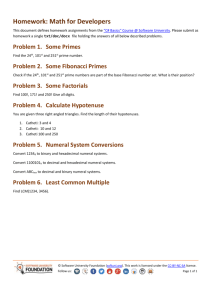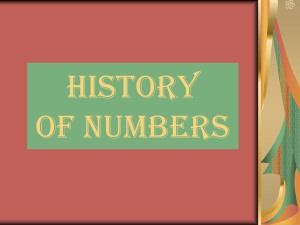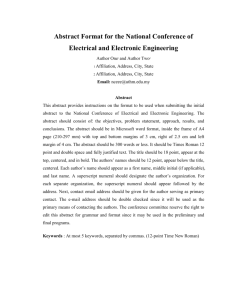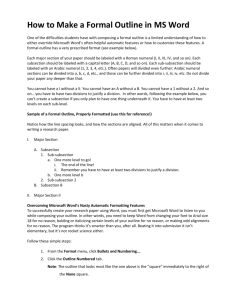a conjecture on numeral systems
advertisement
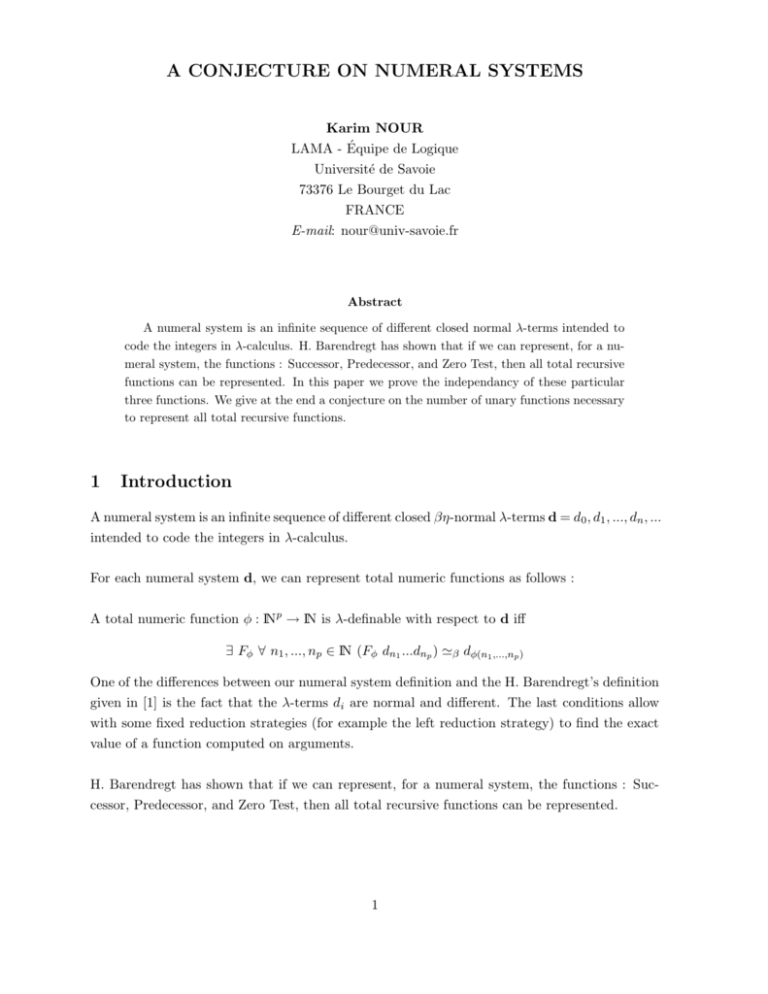
A CONJECTURE ON NUMERAL SYSTEMS Karim NOUR LAMA - Équipe de Logique Université de Savoie 73376 Le Bourget du Lac FRANCE E-mail: nour@univ-savoie.fr Abstract A numeral system is an infinite sequence of different closed normal λ-terms intended to code the integers in λ-calculus. H. Barendregt has shown that if we can represent, for a numeral system, the functions : Successor, Predecessor, and Zero Test, then all total recursive functions can be represented. In this paper we prove the independancy of these particular three functions. We give at the end a conjecture on the number of unary functions necessary to represent all total recursive functions. 1 Introduction A numeral system is an infinite sequence of different closed βη-normal λ-terms d = d0 , d1 , ..., dn , ... intended to code the integers in λ-calculus. For each numeral system d, we can represent total numeric functions as follows : A total numeric function φ : IN p → IN is λ-definable with respect to d iff ∃ Fφ ∀ n1 , ..., np ∈ IN (Fφ dn1 ...dnp ) 'β dφ(n1 ,...,np ) One of the differences between our numeral system definition and the H. Barendregt’s definition given in [1] is the fact that the λ-terms di are normal and different. The last conditions allow with some fixed reduction strategies (for example the left reduction strategy) to find the exact value of a function computed on arguments. H. Barendregt has shown that if we can represent, for a numeral system, the functions : Successor, Predecessor, and Zero Test, then all total recursive functions can be represented. 1 We prove in this paper that this three particular functions are independent. We think it is, at least, necessary to have three unary functions to represent all total recursive functions. This paper is organized as follows: • The section 2 is devoted to preliminaries. • In section 3, we define the numeral systems, and we present the result of H. Barendregt. • In section 4, we prove the independancy of the functions: Successor, Predecessor, and Zero Test. We give at the end a conjecture on the number of unary functions necessary to represent all total recursive functions. 2 Notations and definitions The notations are standard (see [1] and [2]). • We denote by I (for Identity) the λ-term λxx, T (for True) the λ-term λxλyx and by F (for False) the λ-term λxλyy. • The pair < M, N > denotes the λ-term λx(x M N ). • The β-equivalence relation is denoted by M 'β N . • The notation σ(M ) represents the result of the simultaneous substitution σ to the free variables of M after a suitable renaming of the bound variables of M . • A βη-normal λ-term is a λ-term which does not contain neither a β-redex [i.e. a λ-term of the form (λxM N )] nor an η-redex [i.e. a λ-term of the form λx(M x) where x does not appear in M ]. The following result is well known (Bőhm Theorem): If U, V are two distinct closed βη-normal λ-terms then there is a closed λ-term W such that (W U ) 'β T and (W V ) 'β F . • Let us recall that a λ-term M either has a head redex [i.e. M = λx1 ...λxn ((λxU V ) V1 ...Vm ), the head redex being (λxU V )], or is in head normal form [i.e. M = λx1 ...λxn (x V1 ...Vm )]. • The notation U V means that V is obtained from U by some head reductions and we denote by h(U, V ) the length of the head reduction between U and V . • A λ-term is said solvable iff its head reduction terminates. 2 The following results are well known : - If M is β-equivalent to a head normal form then M is solvable. - If U V , then, for any substitution σ, σ(U ) σ(V ), and h(σ(U ), σ(V ))=h(U,V). In particular, if for some substitution σ, σ(M ) is solvable, then M is solvable. 3 Numeral systems • A numeral system is an infinite sequence of different closed βη-normal λ-terms d = d0 , d1 , ..., dn , .... • Let d be a numeral system. – A closed λ-term Sd is called Successor for d iff : (Sd dn ) 'β dn+1 for all n ∈ IN. – A closed λ-term Pd is called Predecessor for d iff : (Pd dn+1 ) 'β dn for all n ∈ IN. – A closed λ-term Zd is called Zero Test for d iff : (Zd d0 ) 'β T and (Zd dn+1 ) 'β F for all n ∈ IN. • A numeral system is called adequate iff it possesses closed λ-terms for Successor, Predecessor, and Zero Test. Examples of adequate numeral systems 1) The Barendregt numeral system For each n ∈ IN, we define the Barendregt integer n by : 0 = I and n + 1 =< F, n >. It is easy to check that S = λx < F, x >, P = λx(x F ), Z = λx(x T ). are respectively λ-terms for Successor, Predecessor, and Zero Test. 2 2) The Church numeral system For each n ∈ IN, we define the Church integer n = λf λx(f (f...(f x)...)) (f occurs n times). It is easy to check that 3 S = λnλf λx(f (n f x)), P = λn(n U < 0, 0 > T ) where U = λa < (s (a T )), (a F ) >, Z = λn(n λxF T ). are respectively λ-terms for Successor, Predecessor, and Zero Test. 2 Each numeral system can be naturally considered as a coding of integers into λ-calculus and then we can represent total numeric functions as follows. • A total numeric function φ : IN p → IN is λ-definable with respect to a numeral system d iff ∃ Fφ ∀ n1 , ..., np ∈ IN (Fφ dn1 ...dnp ) 'β dφ(n1 ,...,np ) The Zero Test can be considered as a function on integers. Indeed : Lemma 1 A numeral system d has a λ-term for Zero Test iff the function φ defined by : φ(0) = 0 and φ(n) = 1 for every n ≥ 1 is λ-definable with respect to d. Proof It suffices to see that d0 and d1 are distinct βη-normal λ-terms. 2 H. Barendregt has shown in [1] that : Theorem 1 A numeral system d is adequate iff all total recursive functions are λ-definable with respect to d. 4 Some results on numeral systems Theorem 2 1 There is a numeral system with Successor and Predecessor but without Zero Test. Proof For every n ∈ IN, let an = λx1 ...λxn I. It is easy to check that the λ-terms Sa = λnλxn and Pa = λn(n I) are λ-terms for Successor and Predecessor for a. Let ν, x, y be different variables. If a possesses a closed λ-term Za for Zero Test, then : (Za an x y) 'β 1 x y if n = 0 if n ≥ 1 This Theorem is the exercise 6.8.21 of Barendregt’s book (see [1]). We give here a proof based on the techniques developed by J.-L. Krivine in [3]. 4 and (Za an x y) x y if n = 0 if n ≥ 1 Therefore (Za ν x y) is solvable and its head normal form does not begin with λ. We have three cases to look at : • (Za ν x y) (x u1 ...uk ), then (Za a1 x y) 6 y. • (Za ν x y) (y u1 ...uk ), then (Za a0 x y) 6 x. • (Za ν x y) (ν u1 ...uk ), then (Za ak+2 x y) 6 y. Each case is impossible. 2 Theorem 3 There is a numeral system with Successor and Zero Test but without Predecessor. Proof Let b0 =< T, I > and for every n ≥ 1, bn =< F, an−1 >. It is easy to check that the λ-terms Sb = λn < F, ((n T ) a0 λx(n F )) > and Zb = λn(n T ) are λ-terms for Successor and Zero Test for b. If b possesses a closed λ-term Pb for Predecessor, then the λ-term Pb0 = λn(Pb < F, n > T ) is a λ-term for Zero Test for a. A contradiction. 2 Remarks 1) Let b00 = b1 , b01 = b0 , and for every n ≥ 2, b0n = bn . It is easy to check that the numeral system b0 does not have λ-terms for Successor, Predecessor, and Test for Zero. 2) The proofs of Theorems 1 and 2 rest on the fact that we are considering sequences of λ-terms with a strictly increasing order (number of abstractions). Considering sequences of λ-terms with a strictly increasing degree (number of arguments) does not work as well. See the following example. We define 0̃ = I and for each n ≥ 1, ñ = λx(x x...x) (x occurs n + 1 times). Let S̃ = λnλx(n x x), Z̃ = λn(n A I I T ) where A = λxλy(y x), P̃ = λnλx(n U F ) where U = λy(y V I) and V = λaλbλcλd(d a (c x)) It is easy to check that S̃, Z̃, and P̃ are respectively λ-terms for Successor, Zero Test, and Predecessor. 2 5 Definitions • We denote by Λ0 the set of closed λ-terms and by Λ1 the set of the infinite sequences of closed normal λ-terms. It is easy to see that Λ0 is countable but Λ1 is not countable. • For every finite sequence of λ-terms U1 , U2 , ..., Un we denote by < U1 , U2 , ..., Un > the λ-term < ... << I, U1 >, U2 >, ..., Un >. • Let U=U1 , U2 , ... be a sequence of normal closed λ-terms. A closed λ-term A is called generator for U iff : (A I) 'β U1 and (A < U1 , U2 , ..., Un >) 'β Un+1 for every n ≥ 1 Lemma 2 There is a sequence of normal closed λ-terms without generator. Proof If not, let φ be a bijection between Λ0 and IN and Φ the function from Λ1 into Λ0 defined by: Φ(U) is the generator GU such that φ(GU ) is minimum. It is easy to check that Φ is a one-to-one mapping. A Contradiction. 2 Theorem 4 There is a numeral system with Predecessor and Zero Test but without Successor. Proof Let e be a sequence of normal closed λ-terms without generator. Let c0 = I and for every n ≥ 1, cn =< cn−1 , en >. It is easy to check that the λ-terms Pc = λn(n T ) and Zc = λn(n λxλyI T F T ) are λ-terms for Predecessor and Zero Test for c. If c possesses a closed λ-term Sc for Successor, then the λ-term Sc0 = λn(Sc n F ) is a generator for e. A Contradiction. 2 The result of H. Barendregt (Theorem 1) means that, for a numeral system, it suffices to represent three particular functions in order to represent all total recurcive functions. We have proved that these three particular functions are independent. We think it is, at least, necessary to have three functions as is mentioned below : Conjecture There are no total recursive functions f, g : IN → IN such that : for all numeral systems d, f, g are λ-definable iff all total recursive functions are λ-definable with respect to d. If we authorize the binary functions we obtain the following result : 6 Theorem 5 There is a binary total function k such that for all numeral systems d, k is λdefinable iff all total recursive functions are λ-definable with respect to d. Proof Let k the total binary function defined by : k(n, m) = ( n+1 if m = 0 |n − m| if m 6= 0 It suffices to see that : k(n, n) = 1 0 if n = 0 , if n = 6 0 k(n, 0) = n + 1, k(n, 1) = n − 1 if n 6= 0. 2 Acknowledgement. We wish to thank Mariangiola Dezani and René David for helpful discussions. We also thank Enrico Tronci and Nőel Bernard for their help in the writing of this paper. References [1] Barendregt, H., ”The lambda calculus, its syntax and semantics,” edited by North Holland, 1984. [2] Krivine, J-L., ”Lambda calcul, types et modèles,” edited by Masson, 1990. [3] Krivine, J-L., ”Opérateurs de mise en mémoire et traduction de Gődel,” Archiv for Mathematical Logic vol. 30 (1990), pp. 241-267. [4] Nour, K., ”An example of a non adequate numeral system,” C.R. Acad. Sci. Paris t. 323, Série I, (1996), pp. 439-442. 7

